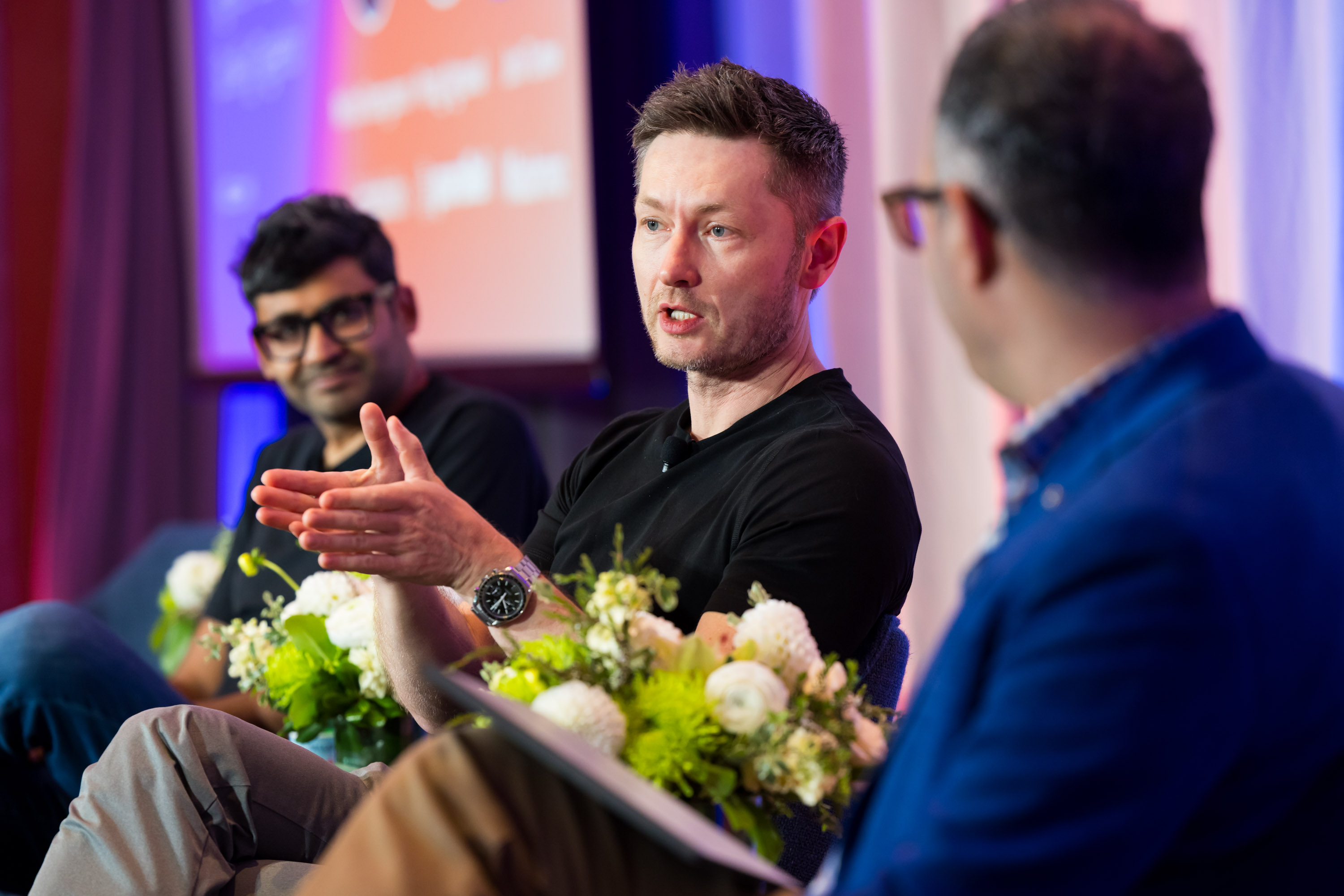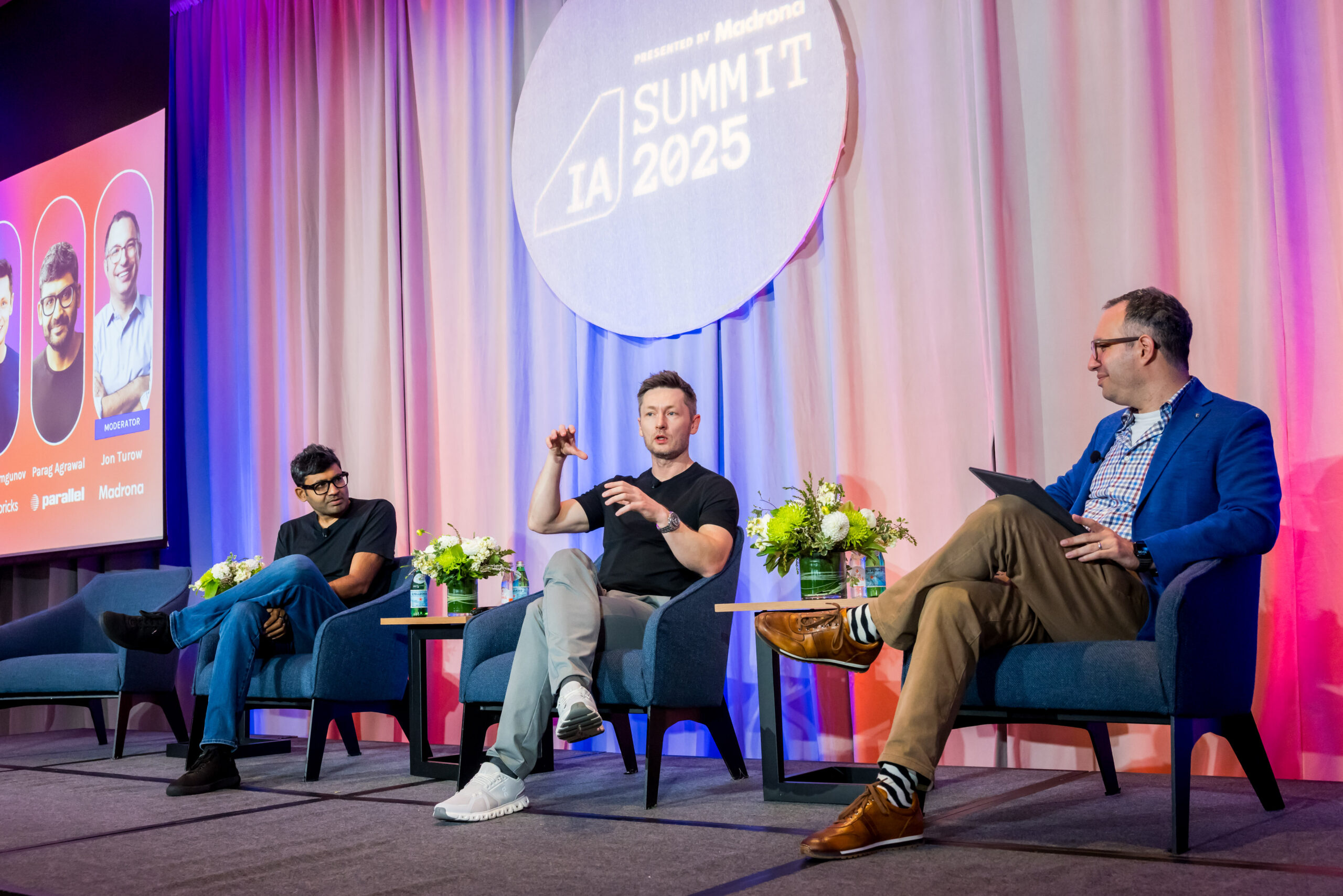
We’ve all heard the tidy story: first comes infrastructure, then applications follow. But that’s not how it really works. Infrastructure and apps evolve together, each forcing the other forward. Right now, that interplay is accelerating faster than ever.
I explored this at the 2025 IA Summit with two founders living that reality: Nikita Shamgunov, a serial infrastructure founder who co-founded SingleStore and later founded Neon (now part of Databricks), and Parag Agrawal, the former CEO of Twitter and founder of Parallel, which is building a web search index for machines rather than humans.
Both made company-defining bets based on what they saw at the intersection of infrastructure and applications. And in both cases, they discovered their customers were no longer people; they were AI agents.
Nikita’s wake-up call came in September 2024. Neon had embedded into developer platforms like Replit, offering serverless Postgres. The uptake was underwhelming. Far less traffic than Vercel or Retool.
Then Replit launched its AI agent. Overnight, usage exploded. Agents were creating new databases at four times the rate of human developers. In fact, more databases came from Replit’s agent than from the rest of the world combined.
Nikita’s go-to-market lead, Arjun, was emphatic: “We are having a moment.”

The retention patterns flipped. Individual apps had low retention because agents create and discard quickly. But user retention was high because of the value agents delivered. This wasn’t just growth; it was a complete redefinition of who the customer was.
For Parag, the bet came earlier. Parallel focused entirely on AIs as customers from day one, not on adapting to existing human use cases. That meant building a new web search index from scratch — something no one had done at scale in decades.
“Having built a past generation of infrastructure on the web where you’re obsessed with imagining a human on a mobile device and how they browse,” Parag explained, “you could see your end customer was about to change completely because an AI was going to sit between you and the end customer.”
The challenge? Building for customers who hadn’t yet arrived. “We started building technology and infrastructure, but our customer hadn’t yet shown up in a very real way.” That required a different kind of conviction: seeing where the market was going before the market itself could see it.
Both founders came to the same conclusion. When you hit this kind of moment, you can’t hedge. As Nikita put it: You see the ones that win lean into disruptions and the ones that lose ignore them. When you don’t lean in, “suddenly you’re selling pagers and the whole world moved to iPhones.”
Leaning in doesn’t mean betting on a single idea. As Nikita Shamgunov explained, when a platform shift hits, clarity is impossible, but you know it’s going to be massive. The only way to learn is by acting. His team “fired a bunch of bullets” — eight major initiatives in all. Four were transformational, two or three missed entirely, and the rest landed somewhere in between.
The results proved it out. Of eight major initiatives, four were immediately transformational. Two or three failed. The rest landed somewhere in between.
“That comes to your batting average,” Nikita said. “Compare that to being careful, hitting every bullet but firing too few. Or not doing it at all, and then you miss the whole wave.”
Takeaway for founders: When the platform is shifting, you’ll never have perfect information. Fire multiple bullets, expect some to miss, and use execution as your learning tool. The bigger risk is firing too few.

Once you’ve recognized the moment and committed to the bet, speed becomes existential. Nikita’s pace was ferocious, decisive, and impossibly fast.
When Anthropic launched the Model Context Protocol in December 2024, Nikita saw immediately that distribution energy was moving toward agents and agent developers. A week later, Neon shipped its MCP server. Two weeks after the re:Invent inflection point, they had spun up a full AI team. Soon after, Nick Turley, head of product for ChatGPT, joined their board.
When you recognize shifts of this magnitude, “you have to play,” Nikita said. “The important thing is that as the world moves and changes, you launch your thing as well.”
Speed became both a forcing function for internal clarity and a signal to the outside world. But not everything had to change. Both founders were deliberate about what to rebuild and what to preserve.
Nikita kept Neon’s high-performance Postgres foundation intact. What changed were the layers around it — retention assumptions, interfaces, and ancillary services like sandboxes. Postgres worked. The question was what to rebuild on top of it.
Parag’s view was more radical. When your customer changes from human to AI, nothing from the traditional search stack survives. Models already have parametric memory, so the index must complement what they know, not duplicate it. Ranking functions must serve model reasoning, not human browsing habits. And agents will shift from pull-based systems to push-based ones triggered by real-time changes on the web.
“Once you decide that everything is going to look so different,” Parag said, “you kind of have to own all the parts of the stack where what we’ve built to date is no longer right.”
For Neon, agents don’t just use databases differently; they create different usage patterns. Apps are cheap and disposable. Sandboxes become essential. Snapshot, rollback, and parallel execution unlock new behaviors.
Nikita framed it through Bezos’s one-way versus two-way door metaphor: “If your infrastructure is such that it is a two-way door, meaning actions can be undone and verified, then I want to give agents an opportunity to just rip.” In other words, infrastructure design enables agent trust and autonomy.
For Parallel, it meant rethinking crawling (what to index when models already know so much), ranking (optimizing for reasoning chains, not click-through rates), and triggering (moving from pull to push as the web becomes an event stream for agents).
Takeaway for founders: When the customer changes, some assumptions break while some hold. Know which is which. Move fast on what must change, and preserve what still works.

You can’t execute pivots like this without changing the team — sometimes radically.
Parag’s philosophy is that risk must be concentrated, not diffused. “If you want to take risk, you have to take risk on the team. There are two types of people on the team. One, people who add a bunch of risk and the corresponding upside to the company. Two, people who are great at working with people who add that kind of risk.”
You need both. All risk-adders with no channelers, and you get chaos instead of focus.
Nikita put it simply: “The team you build is the company you build.” For AI-native infrastructure, you need AI-native talent on the team and on the board.
Bringing Nick Turley onto the board was a strategic move on several levels. It signaled seriousness about AI to the market and to recruits. It gave the team hours at board dinners with someone who deeply understands how AI products work. And it forced them to craft a narrative compelling enough to convince someone like Nick that this infrastructure play mattered.
Takeaway for founders: When building for an uncertain future, team composition is strategy. You need people who add upside in ambiguous environments and people who channel that energy into execution. Get both, or you won’t move fast enough.
Infrastructure and applications are converging to create real-world value at unprecedented speed. The old story — build infra, then apps follow — no longer holds. They’re pushing each other forward in real time.
The winners will spot inflection points early, bet decisively on incomplete information, execute with speed, and rebuild the right parts while preserving what works.
For Nikita and Parag, that meant recognizing their customers were becoming AI agents and reorganizing around that reality. For others, the shift might look different. But the principles are the same: Pay attention to the interplay, move when you see your moment, and don’t wait for perfect information.
Here’s what I’ve learned. The future isn’t just moving faster. It’s being shaped by founders who understand something fundamental: infrastructure and apps don’t take turns. They push each other forward, and the winners are building at that intersection.
If you’re building, investing, or leading in this space, the intersection of infrastructure and applications is where the next wave of opportunity lives. Let’s get to work.